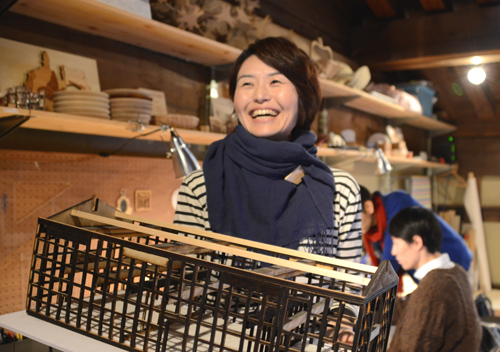
from Kanagawa vol. 66 2014.03.27 Creating work and play - the era of social fabrication -
![]()
Fab Lab. When I first came across this word, I was mystified. What could it possibly mean? Then I discovered that Fab Lab is derived from the words “Fabrication Laboratory” and “Fabulous Laboratory,” and refers to experimental craft centers equipped with digital machine tools such as 3D printers and laser printers, which are becoming increasingly popular across the world.
Our lives are full of stuff. And whatever we need, we can get our hands on. So it seems as though over time we’ve forgotten about what it means to “make” something. But fabrication is one of the most fundamental human needs and we learn a great deal from the process of manufacturing.
Japan is a country well known for its manufacturing prowess. I think there’s a great potential for Japan’s traditional culture and state-of-the-art technology to unite and create a new culture when Japan remembers how fun it can be to manufacture. In order to learn more about Fab Labs, I went and spoke to Ms. Youka Watanabe, the director of Fab Lab Kamakura.
(Text by Miwako Sasao)
目次へ移動 Tradition and technology coexist at "Yuinokura"
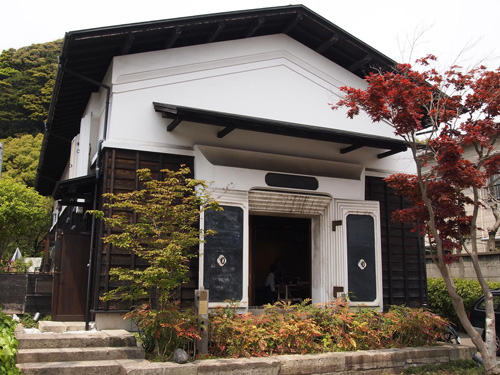 "Yuinokura" - the headquarters of Fab Lab Kamakura. The building exudes Japan's traditional culture. (Photograph provided by Fab Lab Kamakura)
"Yuinokura" - the headquarters of Fab Lab Kamakura. The building exudes Japan's traditional culture. (Photograph provided by Fab Lab Kamakura)
When you get out of the train station at Kamakura, you will find a street that is full of tourists. If you turn around and start walking the other way down through the underground passage, you will find yourself at Fab Lab Kamakura's building, "Yuinokura," standing serenely amid all the noise. This building was once a sake brewery built 125 years ago, and it was moved from Akita to Kamakura in 2004. Using Japan's traditional construction methods, the brewery was taken apart, shipped, and then put back together. I was amazed when I heard that they even shipped soil from Akita and fermented it to use for the clay wall. Fab Lab only uses a portion of the brewery and the rest of the space is currently being used as living quarters, so there are actually people who live there.
When I stepped inside the brewery, I instantly felt the temperature drop, and I also heard a rhythmical, high-pitched mechanical sound. Inside the traditional brewery there were state-of-the-art machine tools like 3D printers and laser cutters hard at work. At a glance, the sight looks a bit mismatched, but strangely it was very cool, and I felt drawn, deeper and deeper into the building. So what exactly happens here?
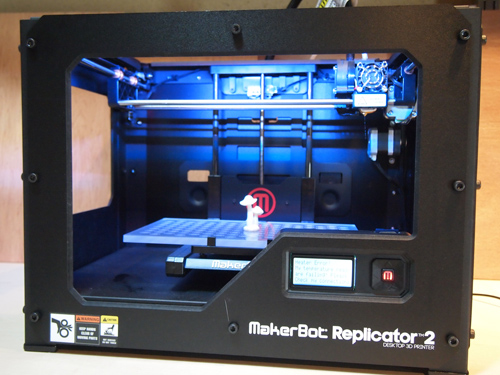 Desktop 3D printer: Replicator 2. You can create 3D objects just as though you were printing a document.
Desktop 3D printer: Replicator 2. You can create 3D objects just as though you were printing a document.
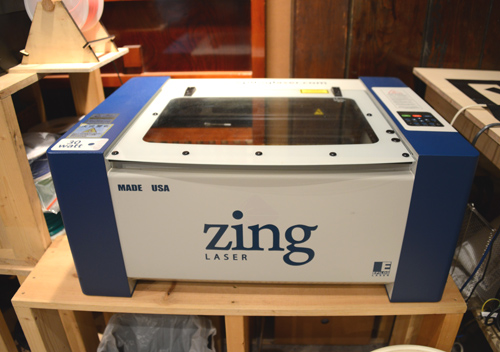 Laser processor: Laser Cutter. It will cut out desired parts in no time.
Laser processor: Laser Cutter. It will cut out desired parts in no time.
I was staring at these fascinating machines when the director of the Fab Lab Kamakura, Ms. Youka Watanabe, came out from the back to welcome me with a warm smile. I first met her at a talk show, and I remembered how awe-inspired I was by her sharp, confident stature, and her passion for her work.
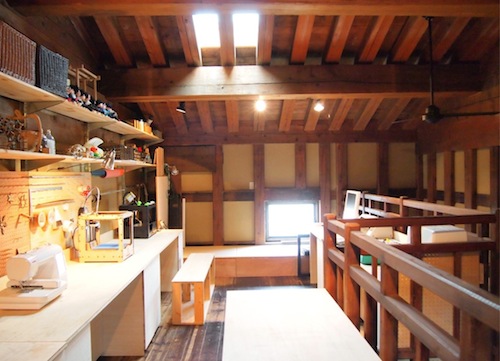 The workshop on the second floor. Fabrication experiments take place here on a daily basis. (Photograph provided by Fab Lab Kamakura).
The workshop on the second floor. Fabrication experiments take place here on a daily basis. (Photograph provided by Fab Lab Kamakura).
目次へ移動 If you want something, make it yourself
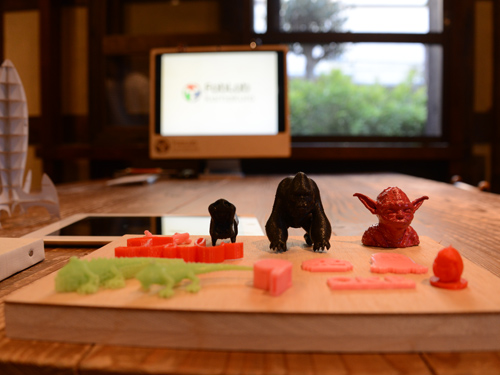 Realistic looking figurines made at Fab Lab Kamakura.
Realistic looking figurines made at Fab Lab Kamakura.
Fab Lab was founded by Professor Neil Gershenfeld of the Massachusetts Institute of Technology (MIT), the pioneer of personal fabrication. Simply put, there is a network of Fab Labs worldwide. It is open to everyone, so you can walk in and use digital machine tools like 3D printers and laser cutters to create something uniquely yours.
The Fab Lab grass roots movement, which began in 2002, has now expanded to more than 200 locations in 50 developed and developing countries. The Fab Lab movement landed in Japan in 2011. Fab Lab Kamakura and Fab Lab Tsukuba were East Asia's first and second Fab Labs. Currently there are 5 other Fab Labs in Japan located in Shibuya, Sendai, Kannai, Kitakagaya, and Oita (as of January 2014). There are other Fab Labs in the works right now all across Japan, from Hokkaido to Okinawa.
A truly wide range of products is created at the Fab Lab. People come to create anything from figurines of their favorite anime character to backpacks that hugs their backs perfectly. A Fab Lab in Spain has large machine tools, and some people even make houses in the lab. The birth of Fab Labs, a place where you can practically make anything you want, has now made it very easy to give shape to your ideas. As a result, very unique "products" are coming to life.
For example, a woman who had taken part in Professor Neil Gershenfeld's "How to Make Anything" created a very interesting piece called "Scream Body." She often felt the need to scream when surrounded by a large crowd of people. So she designed and created a sound proof bag that you can scream into. The bag then records your scream, so you can play it back later when there are less people around to relieve stress.
When I thought about what I might make at the Fab Lab, I came up with many interesting products like a neck holder that would help fix my tendency to cock my head towards the right or a drinking cup designed specifically to help stop hiccups. In today's world, mass production is a prerequisite to manufacturing, so unless there is a certain level of demand, personal needs like these cannot be met. So why not make products I want myself? This simple reason is starting to drive people to learn how to use these digital machine tools, and to take advantage of these technologies to make their own, unique products.
I got to observe people using the machine tools at Fab Lab Kamakura. It was amazing to see how the digital data they were working on on the computer was immediately transformed into an object. Until a minute ago, it was a data file on the computer, but suddenly it was given life.
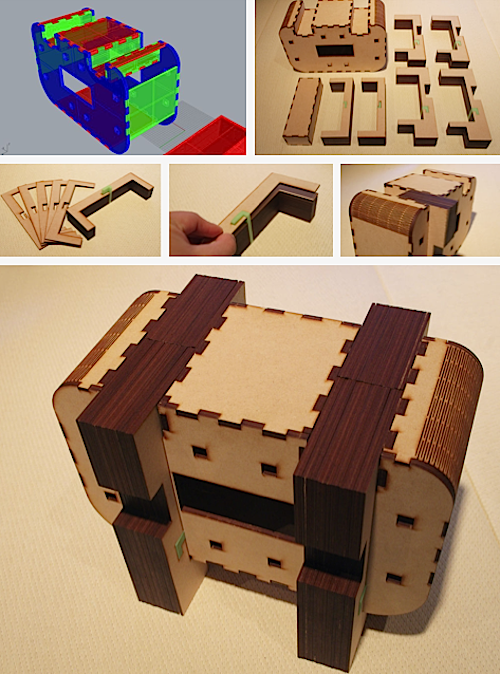 A chair using an interlocking wood structure (no glue necessary). The chair was created by Ms. Michi Komano and Ms. Mio Kato, members of Fab Lab Kamakura. You can download the specs from the link below.
http://www.instructables.com/id/Wood-joinery-stoolkumiki-stool/
A chair using an interlocking wood structure (no glue necessary). The chair was created by Ms. Michi Komano and Ms. Mio Kato, members of Fab Lab Kamakura. You can download the specs from the link below.
http://www.instructables.com/id/Wood-joinery-stoolkumiki-stool/
目次へ移動 Characteristics particular to the region make Fab Labs very attractive
So why was the first Fab Lab created in Kamakura?
"Fab Labs play a key grass roots role in the region, so it's important that they strongly reflect regional characteristics. When we were creating the first Fab Lab in Japan, we wanted to make sure that it would serve as a good pilot case for other Fab Labs following suit. We wanted to make sure that other Fab Labs would be able to become one-of-a-kind, to strongly reflect regional characteristics, and to have originality because it wouldn't be interesting to simply have a cookie cutter like model spread across Japan. And we also wanted Japan's legacy to be a part of our movement. There are certain places that do an superb job of reflecting and emanating the country's culture. The power locations have is not something you can add on afterwards. Because it isn't too far from the city and it has both historical and cultural values, we chose Kamakura."
Ms. Watanabe believes that there are challenges that they can take on, specifically because they are located in Kamakura.
"I think that we will see many more Fab Labs popping up across the country. And I always try to keep a clear vision in mind of what Fab Lab Kamakura should be like when this happens. Kamakura is a residential area with homes and schools nearby, and it is located a little ways from the city center. It's commuting distance from the metropolises, but it's also a provincial city with a population of about 170,000. Because our society is aging very rapidly, I think it's important for regions to become more and more interesting. The baby-boom generation has a lot of experience in manufacturing and they also have great skill, too. But currently, they have nowhere to go once they retire from their jobs. This is such a waste because they are such a great resource. If we are to implement measures to address this aging society, we would rather that they come to Fab Lab and apply their minds and hands to develop new products than go to day care centers. Also, when developing something, there is a height or level you can't reach unless you are relaxed and can feel playful. Active seniors, who have time and money, can exhibit excellent prowess here. They will also have an opportunity to interact with craftsmen, engineers and people from abroad and to grow. I believe that Fab Lab has the potential to become such a place."
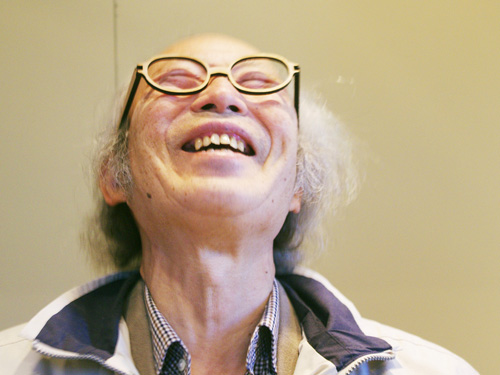 A an active senior in Kamakura, Mr. Hayashi. He makes his own reading glasses. His dream is to create a robotic shrine gate known as torii. (Photograph provided by Fab Lab Kamakura.)
A an active senior in Kamakura, Mr. Hayashi. He makes his own reading glasses. His dream is to create a robotic shrine gate known as torii. (Photograph provided by Fab Lab Kamakura.)
Fab Labs in different regions have different personalities. But can any place that has digital machine tools become a Fab Lab? Not necessarily. There are certain requisites, which are listed on their webpage.
http://fablabjapan.org/whatsfablab/
"It's a regional, yet global lab."
To express this in words is easy, but to implement this fully is a whole different ball game. Even if you have similar machine tools (like 3D printers and laser cutters), needs differ significantly depending on the country or regions' culture and situations. For example, in developed countries, making something may be more about hobbies and learning, but in developing countries it's about subsistence.
Although there may be differences, what lies at the core of each Fab Lab is that "it is a platform for innovation and invention." Although needs may vary, each Fab Lab will most certainly bring change to individuals and societies in that region.
Fab Labs will help personal fabrication (or making something yourself) become something that is more familiar, and you can share your data and know-how with people all around the world via the web.
The ability to create things from data. The ability to travel back and forth between real and virtual worlds. People becoming more connected to other people or regions through "fabrication." All of this has aided the global emergence of a new form of communication known as "social fabrication."
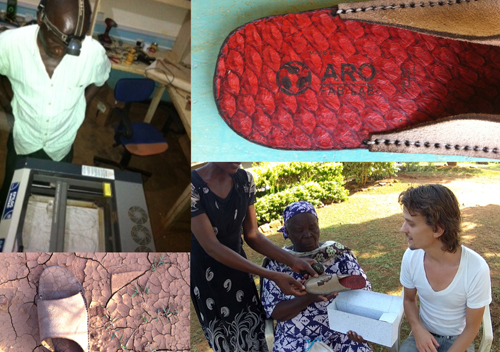 Users in Fab Lab Kenya are using data created at Fab Lab Kamakura (by KULUSKA). A pair of slippers made from the skin of a fish found in Lake Victoria in Africa (upper right). The slippers were presented to President Obama's grandmother (lower right). A single data travels across the world, mutating to the needs of each region. (Photographs provided by Fab Lab Kamakura.
Users in Fab Lab Kenya are using data created at Fab Lab Kamakura (by KULUSKA). A pair of slippers made from the skin of a fish found in Lake Victoria in Africa (upper right). The slippers were presented to President Obama's grandmother (lower right). A single data travels across the world, mutating to the needs of each region. (Photographs provided by Fab Lab Kamakura.
目次へ移動
Being hospitable by not being hospitable
Ms. Watanabe believes that Fab Lab Kamakura serves 3 key roles.
1 Community Lab
2 Research Lab
3 Incubation Lab
"The first year, we concentrated on creating a community. Next we conducted research on the kind of people who come, the community we've created. The characteristics of the visitors differ depending on the kind of program we decide to carry out. We also keep a record of how our users change over the course of their Fab Lab Kamakura visits. And since last year we've begun to fully engage companies and local governments to work on personnel training with an eye on the future, to think about what "learning" fundamentally means, and to focus on business activities."
What she means by business activities is making enough to money to cover Fab Lab's expenses, like rent and labor. Even if you make a car, you need gasoline to actually drive around. Likewise, Fab Lab Kamakura needs money to carry on its activities.
From June 2013, Fab Lab Kamakura has launched a unique open lab format they call "Morning Fab Lab." It's a system that lets people, who come on Monday mornings at 9:00am to clean "Yuinokura," Fab Lab Kamakura's headquarters, use the lab afterwards.
Since it is limited to people who can come at 9:00am on Mondays, naturally, it has attracted people who have a high information sensitivity, who are highly motivated to learn something from their experience at Fab Lab. Recently, they have begun to welcome on a regular basis an elderly gentleman, who is interested in 3D modeling, a housewife, who graduated from an art school, grade school students who are eager to learn, as well as a constant flow of new comers.
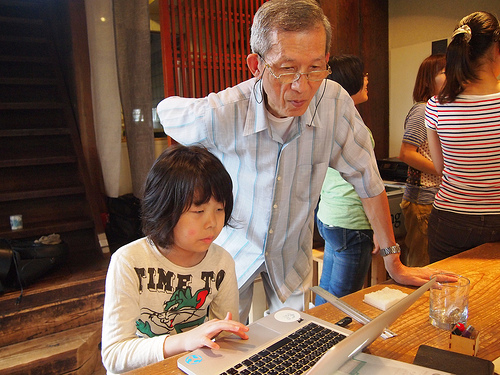 Morning Fab. Mr. Goto (elderly gentleman) and Reiji (boy) come on a regular basis. Regardless of age, the platform has been successful in encouraging communication between people who don't know and people who do know. (Photograph provided by Fab Lab Kamakura.)
Morning Fab. Mr. Goto (elderly gentleman) and Reiji (boy) come on a regular basis. Regardless of age, the platform has been successful in encouraging communication between people who don't know and people who do know. (Photograph provided by Fab Lab Kamakura.)
Ms. Watanabe says that with "Morning Fab" it's important that the Fab Lab Kamakura staff doesn't get involved. Cleaning helps make the relationship between repeaters and first timers more equal, and it also encourages communication. People who have come many times and who now have developed new skills can also teach people how to use laser cutters and other machines.
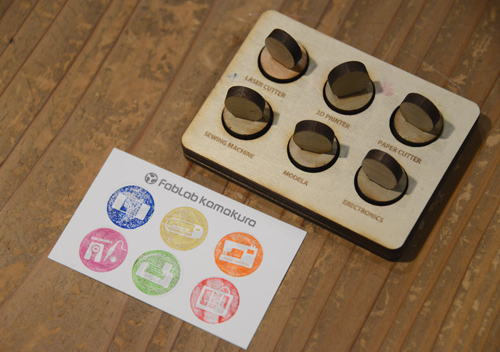 When you learn a new skill or when you've learned to use machines, you get a stamp. Many ingenious measures help keep the motivation of participants high.
When you learn a new skill or when you've learned to use machines, you get a stamp. Many ingenious measures help keep the motivation of participants high.
But they haven't always operated this way. Fab Lab Kamakura has been open on Saturdays, which made it easier for people to come, or tried to make a reservation system, which required people to come directly to make reservations by writing on the black board. Through trial and error, they've arrived at the current "Morning Fab" system.
"At first, I tried to be hospitable. But when you do that, it establishes a clear relationship between a guest (people who come to learn) and host (people who teach). You can tell people to 'please start thinking of this place as your place' but it's not that easy. By eating here, and cleaning up after themselves, we want people to start feelings as though this place is theirs. It took me a year to get used to not being hospitable."
People who have finished the orientation on all the equipment at Fab Lab Kamakura become club members. They also have a program for families called Family Fab. For example, a first year elementary school student created a puzzle with the laser cutter for her younger sister's birthday. It is amazing that these young children can draw 3D diagrams for the laser cutter without being taught.
Perhaps the purest reason for fabrication is not to "learn something new," but "to be able to make something on your own" or "to make something for someone else."
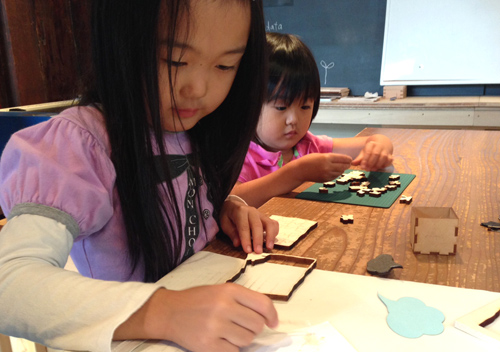 レーザーカッターを使用して3歳の妹(奥)の誕生日にパズルをデザインしてプレゼントをつくるSちゃん6歳(手前)(写真提供:ファブラボ鎌倉)
レーザーカッターを使用して3歳の妹(奥)の誕生日にパズルをデザインしてプレゼントをつくるSちゃん6歳(手前)(写真提供:ファブラボ鎌倉)
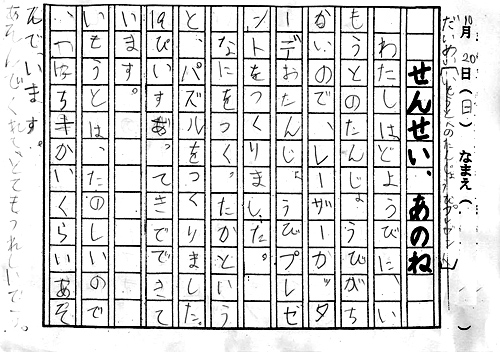
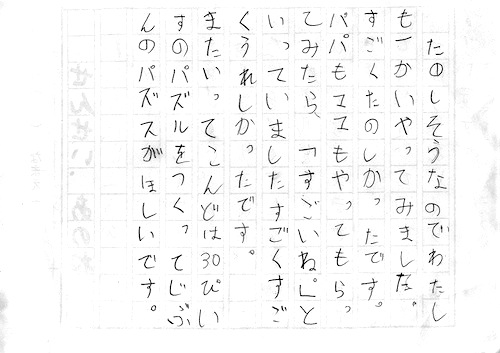 This 6-year old girl (in front) is making a puzzle using the laser cutter for her 3-year old sister (back). (Photograph provided by Fab Lab Kamakura.)
This 6-year old girl (in front) is making a puzzle using the laser cutter for her 3-year old sister (back). (Photograph provided by Fab Lab Kamakura.)
目次へ移動 First encounter with a Fab Lab
What influenced Ms. Watanabe the most to launch Fab Lab Kamakura was her experiences in the U.S.
After high school, she moved to California, and went to a community college in the suburbs of San Francisco. Her class was quite diverse. One of her classmates was visually challenged, another a refugee who had escaped a war torn region, some were hippies and artists. The faculty was also variegated. For example, she had a paraplegic professor. People with very different backgrounds were learning together, and she realized for the first time that this was what diversity means. She was asked there, "What did you come to learn?" And she responded, "English." But her classmates laughed and said, "That's not really an answer." That's when she began thinking about what it was she wanted to learn. In search of an answer, she tried many new things, like traveling all across the country on the train.
"I'm still trying to figure out what Japan is like, so even now I feel like I'm an exchange student here. What's most interesting about Japan, and what makes it unique become more prevalent when you're away. Living abroad helped me realize this."
Upon her return from the U.S., she began attending classes at the Department of Environmental Design, Tama Art University. She kept herself very busy while at the university. She helped out with art projects of Tsumari Echigo's architectural firm, created hanger tunnels for Yokohama's Bank Art. After graduation, she worked at urban design firms and design firms, but one day she got in a car accident, and couldn't work anymore because of the long-term physical therapy. So what did Ms. Watanabe do with her free time? She wanted to do something new, so she read more than 100 books of all genres from philosophy to Japanese classics, and watched nearly 300 movies. Not being able to work and having to go through an intensive physical therapy - for most people this would be quite stressful, but she described this time as a treat.
And in 2010. When she began to readjust to society, she went to the Design to Change the World Exhibition as a web writer. This is where she first learned about Fab Lab and its activities. She thought about it for a week, and then contacted the founder of Fab Lab Japan, Keio University Professor Hiroya Tanaka. When I sat down for a long chat with Professor Tanaka, who was also studying at MIT, he described Fab Lab's concept, that is, "you can virtually make anything you want." "So does that mean that with Fab Lab I could make new jobs for creators, too?" Before she knew it, she had blurted out this question. From this point forward, Ms. Watanabe and Professor Tanaka began working together to create Fab Lab Kamakura.
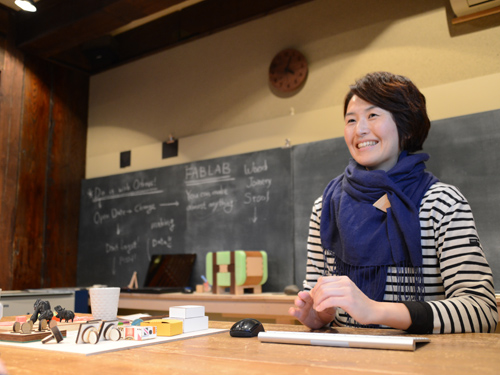 From her early days, Ms. Watanabe was not afraid of taking on a new challenge. Her ability to take action is quite amazing.
From her early days, Ms. Watanabe was not afraid of taking on a new challenge. Her ability to take action is quite amazing.
目次へ移動 Creating jobs for yourself
Any new challenge Ms. Watanabe can think of, she takes on. So what does she do at Fab Lab Kamakura.
"My role here is to bring people together and to provide new values to society. In a nutshell, it's overall project management. Working together with a company's planning division to plan workshops, deciding what kind of people are necessary, how to make the project run smoothly, and things like that."
Ms. Watanabe takes advantage of the know-how and network she has cultivated in Kamakura, and the experiences from the town building and regional development projects to launch projects with companies, local governments, and people of the region. She believes that it is very important to speak to craftsmen and carpenters in Kamakura to create new products, programs, and services, to further facilitate projects. For example, she works together with the Whole Earth Laboratory and young lumberjacks for the FUJI MOCK FES, a 6-month fabrication program that uses timber from forest thinning, which takes place in Mt. Fuji and Kamakura. So she continues to open up new possibilities for Fab Lab Kamakura.
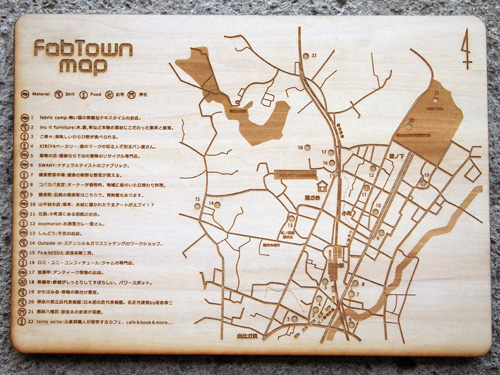 A map of Kamakura as a fab town. It is interesting that this map has turned the entire city of Kamakura into a Fab Lab. (Photograph provided by Fab Lab Kamakura.)
A map of Kamakura as a fab town. It is interesting that this map has turned the entire city of Kamakura into a Fab Lab. (Photograph provided by Fab Lab Kamakura.)
Before my interview with Ms. Watanabe, I had thought that a Fab Lab is a place where you can work in a completely new way. But I had been mistaken.
"When working at Fab Lab Kamakura, it's easier if you have a vision for 'what kind of job you want to create for yourself' rather than simply wanting to work here. And I believe that this place has great potential to serve as a platform for such people. I think it's my job to create a foundation for them. Of course, in the beginning people need support and to use this program to step up, and to have people they can talk to. But it doesn't mean as much if the know-how cultivated here stays in Kamakura. Also, whether it's an art project, regional development project, or an outsider wanting to do something, if we can't get people who live in the region involved, it merely ends as an one-off event. So that's something I try to be mindful of."
Listening to Ms. Watanabe, I could feel her strong commitment to "take on a new challenge, whatever it may be." Perhaps because she feels that "even though you may fail, if you learn something from it, it's not necessarily a failure," she takes on new challenges without hesitation.
目次へ移動 Navigating an uncertain future
Two years since the launch, Ms. Watanabe decided to change Fab Lab Kamakura's focus after she went to the International Fab Lab Conference in New Zealand. Having witness that "learning" is changing all across the world, she changed the focus to "learning" once she returned from the conference.
"In elementary schools around the world, they're trying to both motivate and to teach problem solving. The ability to 'ask questions' is very important. We don't know what kind of future awaits us. In order to navigate an uncertain future, we need to be able to solve problems. And if the our solution has a social impact, it may create jobs, and thereby become a social innovation. Countries like the U.S. are actually already implementing such educational measures."
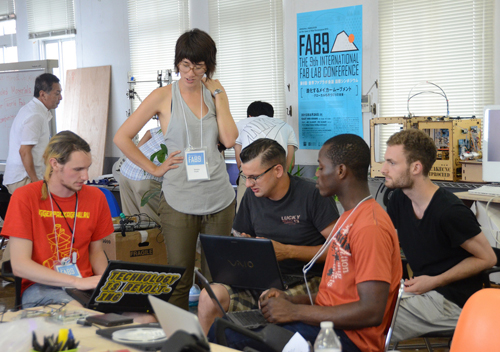 The 9th International Fab Lab Conference held in Japan in 2013. Many people came and share information about the interesting activities in various fields from living, education, to development that they undertake. (Photograph provided by FAB9 Committee.)
The 9th International Fab Lab Conference held in Japan in 2013. Many people came and share information about the interesting activities in various fields from living, education, to development that they undertake. (Photograph provided by FAB9 Committee.)
But in Japan, we create a scenario for what the future may be like, and try to learn something or memorize something in preparation for that future. Ms. Watanabe believes that Japan needs to change its approach to education, or it will be difficult to remain a developed country. This problem doesn't necessarily apply to elementary schools. The same can be said for adults, creators, and university students.
"I realized that the education we've received in Japan doesn't teach us how to learn. When you get used to being reactive to learning, you can't really understand the fundamentals of learning. It's the same with reading a book. You can read books as long as you can read the letters on the page, but there are different ways to read a book."
Fab Lab Kamakura promotes "WEB - FAB - Presentation" as the 21st century version of "reading, writing, and mathematics (abacus)." Giving shape to ideas and implementing them, sharing information - it's important to acquire these skills and the ability to solve problems. I think fabrication is very effective in training us to ask questions. When you make something, many unexpected things happen like machines breaking down, or your product breaking. There are clear tasks in fabrication, and we have to think of how to tackle these tasks, so it's a fantastic learning tool.
As a part of learning, whether you "like" something or not is very importantly, too.
"What fueled imaginations when we were in elementary school directly affect our fundamental ability to adapt. What do you do during your summer break, when you don't have to do anything? You probably end up doing what you naturally like to do without stint in effort or time. This is probably what can be described as your talent. True learning is all about discovering talent. Learning is merely a tool to live better, to communicate, and to get to know more about yourself. So I try to be careful that we don't end up learning simply for learning's sake."
Although you may not be able to tell how far you've come, people around you will notice how different learning has made you. Ms. Watanabe says that "It's ok if only the people around you notice that you've grown." Because many people come to Fab Lab, they help you become aware of your growth and uniqueness that you may not be aware of. If you use the network of 200 locations in Japan and around the world, you can even get ideas and information from people worldwide. This is something you wouldn't have realized if you were making products on your own. Many first movers who have realized a fun way to learn are congregating at Fab Lab.
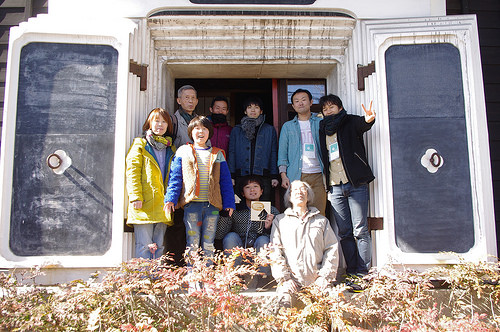 People who like to hang out at Fab Lab Kamakura. (Photograph provided by Fab Lab Kamakura.)
People who like to hang out at Fab Lab Kamakura. (Photograph provided by Fab Lab Kamakura.)
Related websites (in Japanese):
Fab Lab Kamakura(http://www.fablabkamakura.com/)
FabLab Japan(http://fablabjapan.org/)
Reference literature:
"Fab Life - digital fabrication gives way to a future where fabrication methods matter."
(Published by O'Reilly Japan; written by Hiroya Tanaka).
"Fab Lab - bringing innovation to fabrication."
(Published by Mitsubishi UFJ Research and Consulting Co., Ltd.; written by Yuka Watanabe)
Interviews and report by:Miwako Sasao (Think the Earth)
Photographs by:Maho Sekine (Think the Earth)
Edited by: Soichi Ueda (Think the Earth)















